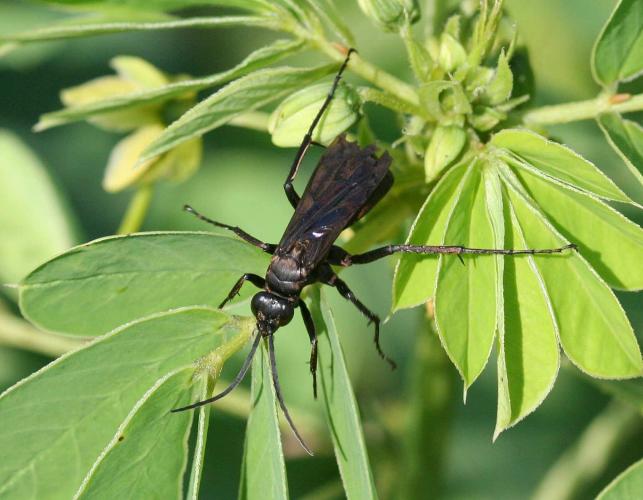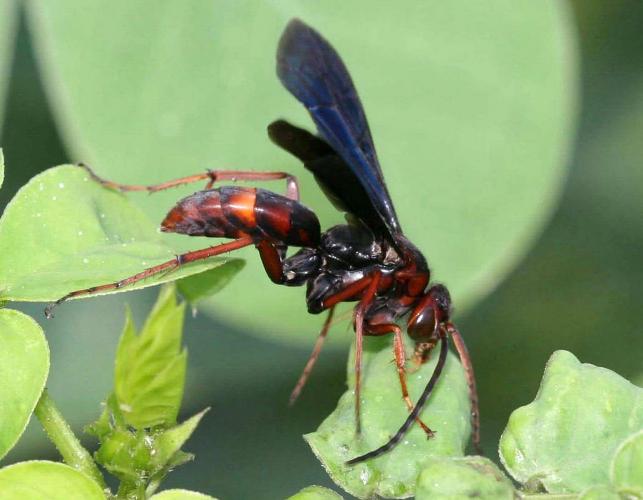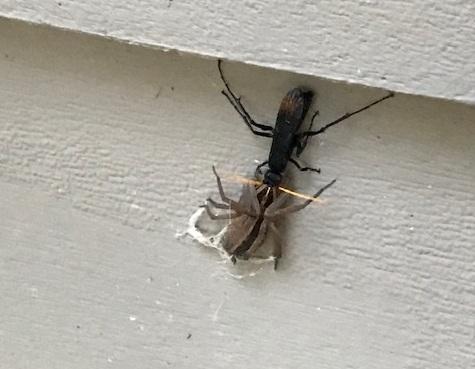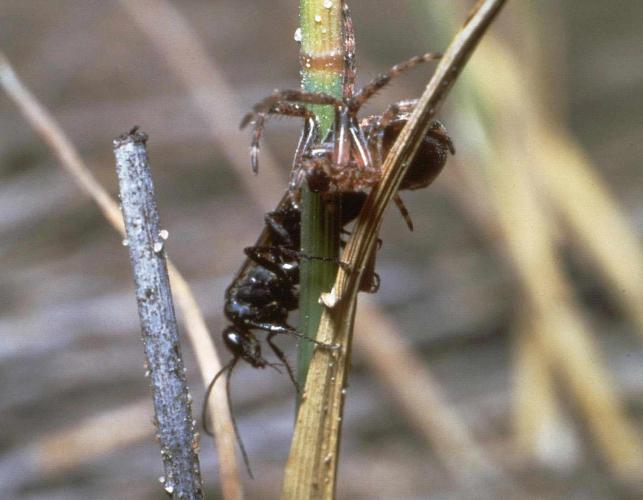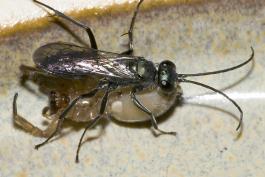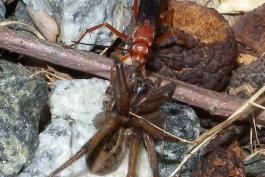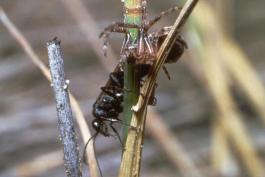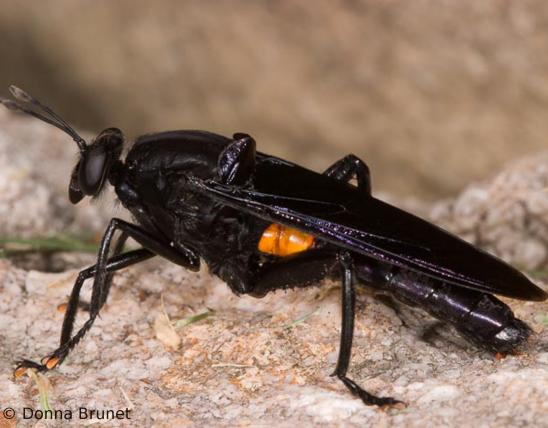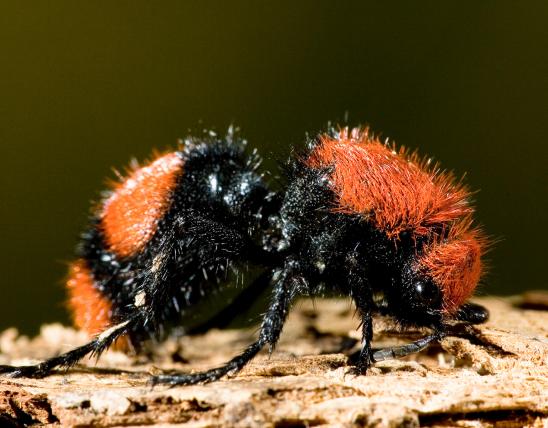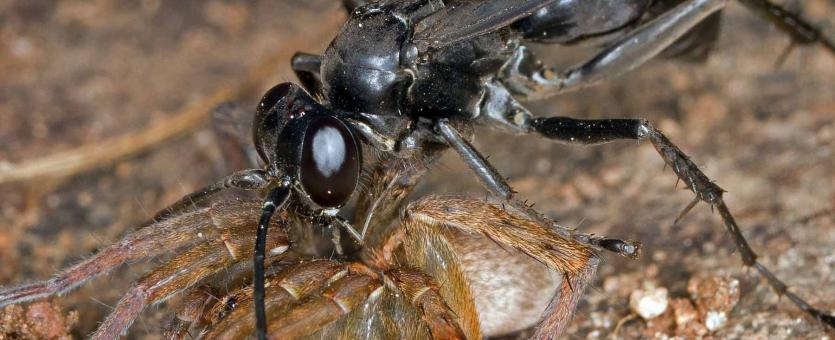
Spider wasps are large wasps with long, spiny legs. Body color varies with species: most are dark — black, shiny blue-black, or brownish. Some species are black with yellow bands, or have orange or rust markings. The wings are often smoky-clear, amber, or dark like the body. Some species have orange or yellow legs or antennae.
To verify their identifications, specialists note details of wing venation, distinctive shapes and groove marks in the body plates, and features of the legs. For example, on the hind pair of legs, a spider wasp has two prominent spines at the outer end of the shinlike section (tibia) of the leg; these spines point outward toward the foot segments (tarsi). Also, when you stretch the hind leg backward, parallel to the rest of the body, the outer tip of the hind femur (the leg segment analogous to the thigh) usually extends beyond the tip of the abdomen.
Similar species: There are many other kinds of dark-colored, medium to large wasps in our state. The extra long, spiny hind legs that often dangle downward in flight, and the nervous flicking of the wings are helpful characters for identification at a glance. The spider-hunting behavior, often on the ground, is another strong clue.
Length: ¼ to 1½ inches.
Statewide. Different species have different distributions.
Habitat and Conservation
Spider wasps occur in a variety of habitats. Species that dig in the ground are usually found in places with loose, workable soil.
With their jerky movements, large size, long legs, and often shiny-black bodies, spider wasps attract the attention of people. Most people see spider wasps as they visit flowers for nectar, or when they walk around on the ground, nervously flicking their wings, hunting for spider prey. Often people spy a female spider wasp as she’s dragging a paralyzed spider to her burrow or other storage place, where the spider’s body will provide food for a larval wasp.
Food
As a larva, a spider wasp eats the body of the spider its mother captured for it, which is enough food for the larva to grow to its full size and begin pupation. Because each larva is provisioned with only one spider, the spiders are generally about the same size as the adult wasp. Most spider wasps prey on free-living spiders (not the kinds that live in webs) — for example, tarantulas, wolf spiders, crab spiders, and jumping spiders — but others capture orbweavers, grass spiders (funnel web weavers), or others. In general, different types of spider wasps specialize in different types of spiders.
As adults, spider wasps sustain themselves by drinking sweet nectar from flowers but may also take juices from fallen or overripe fruit or take sweet honeydew secreted by aphids.
Status
Taxonomically, the spider wasp family is grouped in the same superfamily as the velvet ants (family Mutillidae), myrmosid wasps (family Myrmosidae), and sapygid or club-horned wasps (Sapygidae). Thus they are less closely related to other wasps such as paper wasps, potter wasps, mud daubers, yellowjackets, and hornets.
Scientists suspect that spider wasps represent some of the earth’s more ancestral wasps. (Scientists now usually avoid the term primitive.) Compared to the amazing social organization, prey-carrying, and nest-building capabilities of paper wasps, yellow jackets, and other vespid wasps, spider wasps — dragging their prey backward over the ground, digging a special hole for each egg — have rather rudimentary skills.
Life Cycle
Pompilids are solitary wasps and do not nest in colonies. Males typically hold territories and perch, waiting for receptive females to fly near and fending off rival males. After mating, the female spider wasp locates a suitable prey spider (each species typically has a certain group of spiders it usually hunts) and subdues it by stinging it. She then drags the paralyzed spider to a nest chamber.
Different species use different types of nest chambers. Some females dig burrows into the ground, others build mud cells or use abandoned cells of mud daubers, others use preexisting holes (such as beetle-bored holes in tree trunks, or old burrows of moles or mice), and some use the spider’s own nest or cranny. Some species snip off some or all of the spider’s legs to make it easier to drag around. With the spider tucked away, she lays an egg on it, closes the nest entrance, and repeats the process for each egg she lays.
Upon hatching, the grublike larva chews on the spider’s body, which provides the nourishment for it to grow to full size. Interestingly, the larva generally avoids eating the spider’s vital organs until it’s almost fully grown, which keeps the spider alive and fresh. The larva pupates inside a silken cocoon, and in most species, this is the form that overwinters.
Human Connections
Wowie, zowie! These large, long-legged wasps attract attention as they drag their captured prey — often a good-sized spider — to its doom. We usually think of spiders as fierce (though smallish) predators, but this is a reminder that in nature, the predator is also often the prey.
Although spider wasps are rated as having one of the most painful insect stings, they are not aggressive to people. Unlike social wasps, where many females work together to build communal nests and defend the nest vigorously, spider wasps are laser-focused on their mission to find, capture, and hide their spider prey. Female spider wasps usually only sting people who are attempting to handle them or are otherwise distressing them bodily.
Males (which cannot sting) may look imposing when they buzz around, chasing away intruders, but although they may fly toward us for an inspection, they do not attack people.
The parasitoid life cycle, where a mother lays an egg on a host, and the larva devours the living host, has been the inspiration for many grotesque science fiction monsters, such as the creature in the Alien movies.
In the early 1900s, entomologists — including Missourian Phil Rau — noted an unusual sight: a wasp flying very low over a stream, dragging a spider across the surface film like a wind skier. It remained a mystery species among insect geeks until entomologist and nature writer Howard Ensign Evans identified it as Anoplius depressipes, one of the so-called blue-black spider wasps. It turns out this species hunts fishing spiders (Dolomedes spp.) and possesses specialized flattened front feet that are fringed with hairs, which allow it to walk on water, just like its prey. When transporting a spider, this species grasps the spider with its middle or hind legs, faces forward, then extends its forelegs and uses them like water skis while it propels itself and its prey across the top of the water, beating its wings. (Ahoy, matey!) This spider wasp sometimes dives down into water to chase its prey, since water spiders often swim underwater when frightened. Not surprisingly, it nests in burrows in stream banks.
Ecosystem Connections
Spider wasps are conspicuous and usually have warning colorations (usually combinations of black and yellow, orange, or red) that help to teach would-be predators about their ability to sting. Apparently, in some species, even the males (which do not possess stingers) have a disagreeable smell or taste. Once a flycatcher (for example) is stung by a black-and-orange spider wasp, it knows to avoid similar-looking insects. Many other insects that are perfectly edible and harmless gain protection from predators by having the same coloration, body shape, and even flying style of spider wasps. Mydas flies are an example of these mimics.
Spider wasps are called parasitoids because their larvae, like parasites, take nourishment from a living host — but unlike typical parasites, they ultimately kill their hosts (hence the word’s "-oid" ending). Other parasitoid animals include tachinid flies, some types of ground beetles, and ichneumon and braconid wasps. (Braconids are the insects that are famous for eating a hornworm’s body juices from the inside, then pupating in small silken cocoons on the caterpillar’s outer skin.)
In some cases, if a spider stung by a spider wasp manages to escape being buried with an egg on it, the spider can eventually recover and survive its brush with doom. Numerous studies have been made of the stinging behavior of various spider wasps; some use a few quick stings to initially subdue a spider, then administer another sting, slowly, into the underside of the front of the body, where the nervous system is most concentrated. After that, the spider is probably a goner.
Tarantula hawk wasps (Pepsis and Hemipepsis spp.) are in this family, and they are famous for their large size, long stingers, and excruciating stings (should anyone dream of handling them). They specialize in capturing tarantulas, so these wasps are most numerous and diverse in the desert southwest, where tarantulas are abundant. If you go to the desert southwest, keep an eye out for these huge insects! (Or, look for videos of their battles online.)
One species of tarantula hawk is found throughout the eastern United States: the elegant tarantula hawk (Pepsis menechma). It feeds, however, mostly on trapdoor spiders, not tarantulas. It is glossy blue-black with bright yellow antennae. Also, the southwestern species P. pallidolimbata has been found in southwestern Kansas, so it’s not unreasonable to think that it or another widespread southwestern species might eventually be seen in southwest Missouri — the part of our state where tarantulas are most abundant.




